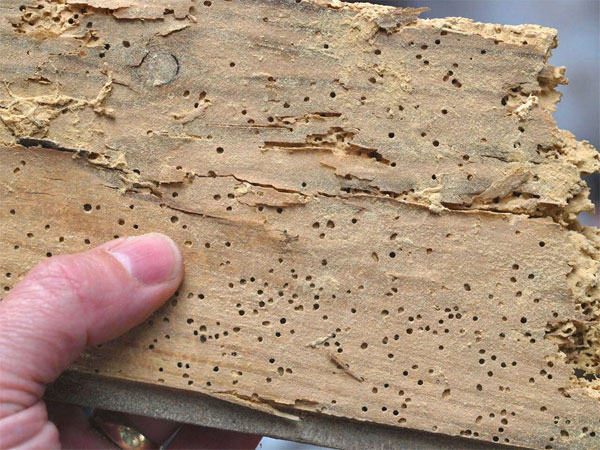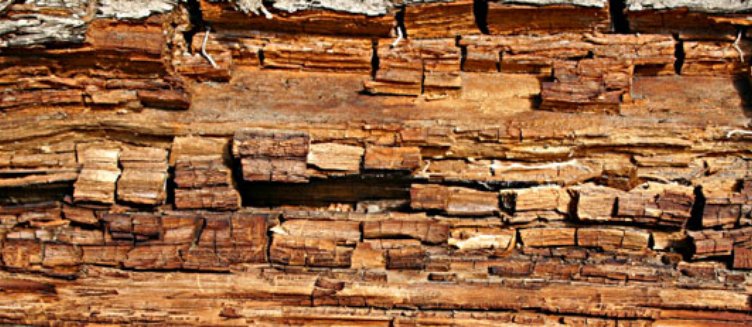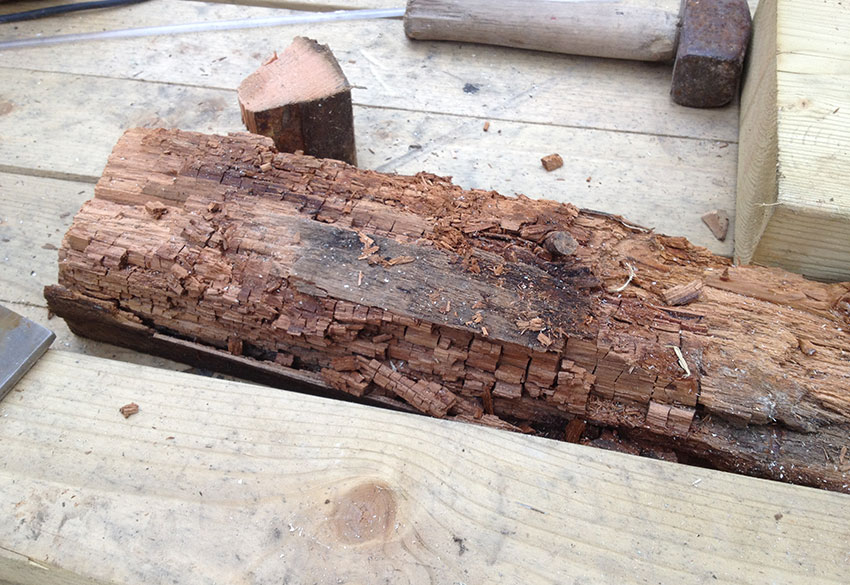Timber preservation
Contents |
[edit] Introduction
It is common for infestations such as wood-rotting fungi and woodworm to cause damage to untreated timber in buildings. This can not only cause decay of the building fabric, if left untreated, the structural integrity of the building can be put at risk leading to substantial costs for repair and refurbishment.
However, there are a wide range of chemical preservatives available that impregnate the wood cells, making them more durable and resistant to decay, insects, weathering and even fire.
[edit] Types of problem
The three problems most likely to affect timber are woodworm, dry rot and wet rot.
[edit] Woodworm
Woodworm infestation of untreated timber is a relatively common problem. The House Longhorn beetle was a particular problem in the UK prior to the introduction of pretreated timber in the 1960s.
The House Longhorn beetle measures up to 25 mm long when mature, and can lay up to 200 eggs on the rough surface of untreated timber. After 2-3 weeks, the larvae emerge and bore into the timber. They can be detected by the powdery deposits known as ‘frass’ left on the surface and the bore holes of around 3 mm diameter.
Other woodborer insects include:
- Furniture beetle: These are 6-8 mm long and lay 20-50 eggs on soft or hardwoods.
- Lyctus powder post beetle: These are 10-15 mm long and lap 70-200 eggs on the sapwood of new hardwood.
- Death Watch beetle: Around 7 mm long and lay 40-80 eggs on hardwood. Are a particular problem on oak timbers found in old churches and similar buildings.
For more information, see Woodworm.
[edit] Dry rot
Dry rot is a white fungal thread which attract dampness from the air or adjacent materials. Strands bearing spores or seeds develop on the threads which drift with air movements to settle and germinate on timber. Signs of dry rot are deep transverse and longitudinal cracking, distinctive cube-like shapes, and light-brown discolouration.
This is more difficult to control than wet rot as the root system can penetrate damp and porous plaster, brickwork and concrete.
For more information, see Dry rot.
[edit] Wet rot
Wet rot can occur where there is the continual presence of moisture, such as leaking pipework, a lack of ventilation which results in condensation, or a defective damp proof course. The growth pattern is similar to dry rot but spores will not germinate in dry timber.
Wet rot can be recognised by fungal threads of black or dark blown colour, large longitudinal cracking with minor lateral cracks.
For more information, see Wet rot.
[edit] Preservative treatments
The most common preservative treatments are applied by a process that drives the protective chemicals and the solvent, which is the vehicle that carries the preservatives, into the timber under pressure.
[edit] Boron salts
Boron provides effective protection against attack by woodborers. It is particularly effective in protecting the sapwood of susceptible hardwoods from Lyctus powder post beetles. Freshly sawn timber is soaked in solutions of boron salts which diffuse through the timber.
[edit] Copper, chromium and arsenic salts (CCA)
CCA is a mixture of water and salts that are pressure-impregnated into timber. The wood is protected against woodborers by the arsenic component; against fungal degradation by the copper component; while the chromium component chemically locks the elements into the timber. While CCA treatment inhibits fungal and termite attack, it has no effect on weathering in sunlight, and so some sealant should be applied if weathering of the timber is considered a potential problem.
[edit] Light organic solvent-borne preservative (LOSP)
A light organic solvent can be used to take preservative chemicals into the timber. Most LOSP contain fungicide, insecticide and wax to give the surface water repellent properties. It is drawn out in the last stages of treatment, leaving the preservative behind. Timber treated by LOSP does not swell and is unchanged in appearance, which makes it an appropriate treatment for appearance or quality applications, such as external joinery, for example, windows.
[edit] Alkaline copper quat (ACQ)
ACQ contains copper and a quaternary ammonium compound. It protects against decay fungi and insects. It can be painted or stained when dry.
[edit] Copper azole
This is an arsenic-free preservative treatment that can be used in water-borne pressure treatment processes. It is odourless and can be stained or painted when finished.
[edit] Creosote and pigment emulsified creosote (PEC)
Creosote and PEC are oil-borne preservatives that can be painted onto timber surfaces, but can also be applied in a pressure-based process for better penetration. They are not odourless due to their volatile components, which means they are only suitable for use in external or industrial applications.
[edit] Application
Most common processes are pressure treatments. The basic steps are as follows:
- The timber is placed in a pressure vessel designed to be able to give a positive and a negative pressure (suction).
- Moisture is sucked out of the timber. The suction opens up pores that make it easier to drive the chemicals into the timber.
- The vessel is placed under pressure and the chemicals and solvent are forced into the timber, varying the pressure if necessary.
- The pressure is released, chemicals are removed from the vessel, and once the chamber is drained, the timber is removed.
- Timber is left to stand.
- The solvent is removed from the timber by air-drying to bring the moisture content down to around the fibre saturation point (where all free water has been removed leaving only water bound in the timber cell walls).
[edit] Treatment
To treat rot, all affected timber as well as timber within 500 mm of fungal attack must be removed. Contaminated plaster should be removed and adjacent mortar joints to masonry should be raked out. For wet rot, as long as the source of dampness has been removed and the affected area has been allowed to dry, this should be sufficient. For dry rot, the surfaces of masonry and concrete may need to be sterilised using a fungicide.
[edit] Related articles on Designing Buildings
- A guide to the use of urban timber FB 50.
- Adhesives.
- Ancient Woodland.
- Building preservation archive.
- Chip carving.
- Damp and timber report.
- Domestic roofs.
- Dry rot.
- European Union Timber Regulation.
- Forests.
- Glulam.
- Laminated veneer lumber LVL.
- Pew.
- Plywood.
- Preservation.
- Recognising wood rot and insect damage in buildings.
- Remedial work.
- Roofing defects.
- Sacrificial timber.
- Timber.
- Timber framed buildings and fire.
- In-situ reinforcement of timber beams.
- Wet rot.
- Woodworm.
- Woodworm and spiders.
[edit] External references
- ‘Building Construction Handbook’ (6th ed.), CHUDLEY, R., GREENO, R., Butterworth-Heinemann (2007)
IHBC NewsBlog
Images from inside a Grade II listed hotel show the scale of its collapse
The Corbett Arms in Tywyn has fallen into serious disrepair.
Old Sarum fire in listed (& disputed) WW1 Hangar - Wiltshire Council has sought legal advice after fire engulfed a listed First World War hangar that was embroiled in a lengthy planning dispute.
UK Antarctic Heritage Trust launches ‘Virtual Visit’ website area
The Trust calls on people to 'Immerse yourself in our heritage – Making Antarctica Accessible'
Southend Council pledge to force Kursaal owners to maintain building
The Council has pledged to use ‘every tool in the toolbox’ if urgent repairs are not carried out.
HE’s Research Magazine publishes a major study of the heritage of England’s suburbs
The article traces the long evolution of an internal programme to research 200 years of suburban growth
IHBC Context 183 Wellbeing and Heritage published
The issue explores issues at the intersection of heritage and wellbeing.
SAVE celebrates 50 years of campaigning 1975-2025
SAVE Britain’s Heritage has announced events across the country to celebrate bringing new life to remarkable buildings.
IHBC Annual School 2025 - Shrewsbury 12-14 June
Themed Heritage in Context – Value: Plan: Change, join in-person or online.
200th Anniversary Celebration of the Modern Railway Planned
The Stockton & Darlington Railway opened on September 27, 1825.
Competence Framework Launched for Sustainability in the Built Environment
The Construction Industry Council (CIC) and the Edge have jointly published the framework.
















